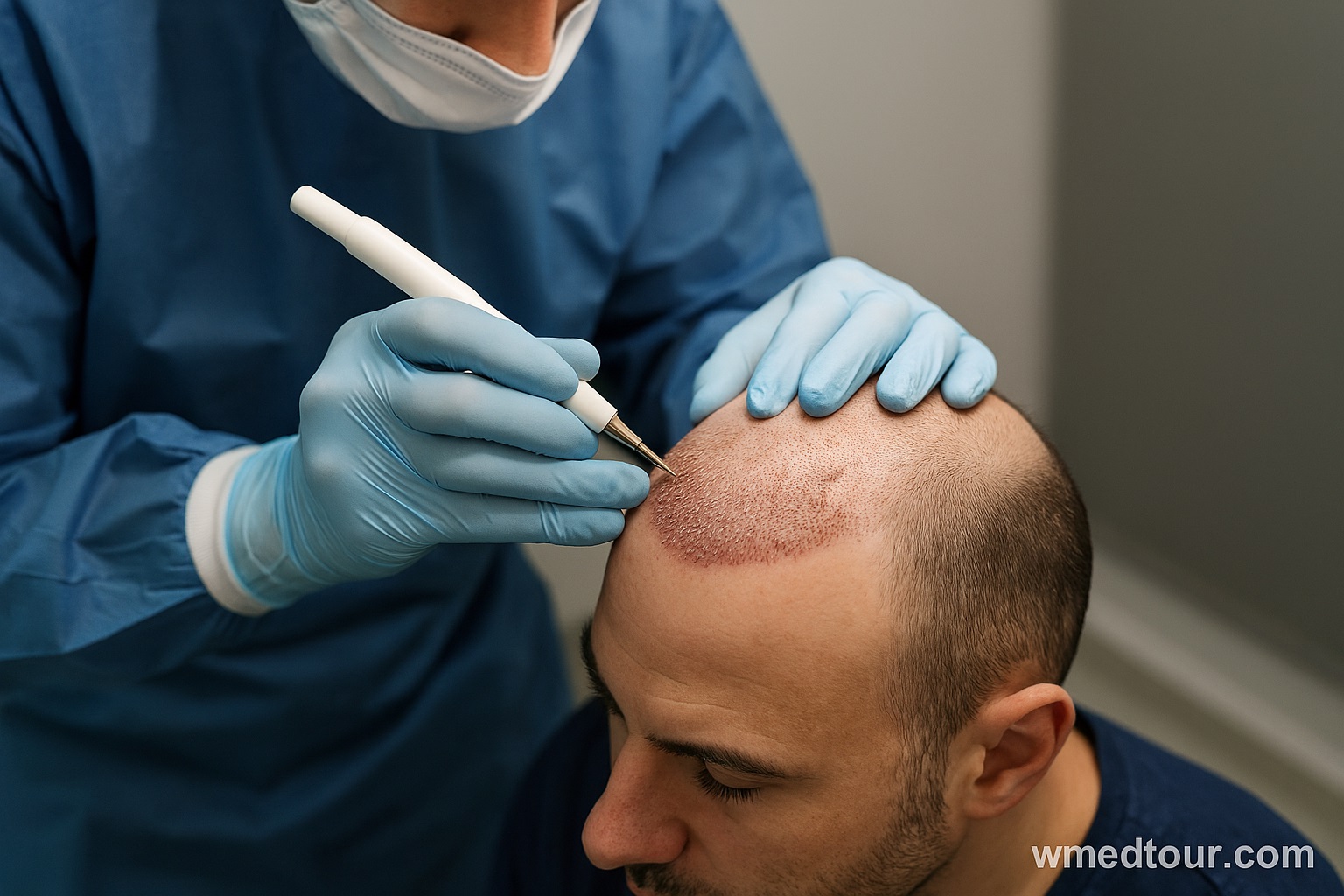DHI Hair Transplant: The Ultimate Guide to Direct Hair Implantation
DHI Hair Implant Technique Guide: Everything you need to know about the Direct Hair Implantation method, from procedure to results and why it might be the right choice for you.
Published on: [Current Date]
What is DHI Hair Transplant? A Breakthrough in Hair Restoration
Hair loss is a common concern, but medical science has made incredible strides in hair restoration. Among the most innovative techniques is the **Direct Hair Implantation (DHI)** method. DHI is a refined version of the FUE (Follicular Unit Extraction) technique, but it stands out because it uses a specialized tool called the **Choi Implanter Pen**. This pen allows the surgeon to extract hair follicles and then immediately implant them into the recipient area. The key difference is the simultaneous creation of the incision and the placement of the graft, a single, streamlined step that is more efficient than traditional FUE. This makes DHI a popular choice for those seeking a natural-looking and efficient hair transplant.
Pioneered by the DHI Global Medical Group, the technique is a minimally invasive procedure performed under local anesthesia. It is known for delivering very natural results because the surgeon has complete control over the angle, depth, and direction of each implanted hair follicle. This precision is crucial for creating a natural and aesthetically pleasing hairline and is a major reason why many people choose DHI for hairline restoration and increasing hair density. For more on different methods, you can check out our guide on The Best Hair Transplant Methods.
How the DHI Procedure Works: Step-by-Step Breakdown
The DHI hair transplant procedure is a meticulous process requiring a skilled and experienced surgeon. It begins with a detailed consultation and scalp analysis to determine the extent of hair loss and plan the ideal hairline. Next, the donor area, typically the back of the head, is anesthetized. Individual hair follicles are carefully extracted one by one using a fine-tipped micro-punch tool. The extracted grafts are then stored in a special solution to maintain their viability, a step similar to FUE.
The subsequent step is where DHI shines. Using the **Choi Implanter Pen**, the surgeon loads each individual graft and directly implants it into the recipient site. This tool eliminates the need for separate incisions and allows for the precise control of the angle and depth of each graft, which is a key factor in achieving a natural look. The direct implantation method also reduces the time the grafts are outside the body, potentially increasing their survival rate. For more on graft counts, read our post, Hair Transplant: How Many Grafts Do You Need?
DHI vs. FUE: A Head-to-Head Comparison
Deciding between DHI and FUE is a common step for patients. While both techniques are based on Follicular Unit Extraction, their differences lie in the implantation phase. The **FUE method** involves two separate steps: the surgeon first creates recipient channels with a blade, then places the grafts into these channels using forceps. This two-step process can be effective, but it lacks the directness of DHI.
In contrast, the **DHI technique** uses the Choi Implanter Pen to combine these two steps into one. The pen creates the recipient channel and implants the graft simultaneously. This single-step process is less traumatic to the scalp, often leading to faster healing and a higher graft survival rate. The Choi pen also provides the surgeon with unparalleled control over hair angle and direction, allowing for denser, more natural-looking results. However, DHI can be more time-consuming and expensive. Both techniques have high success rates, but your suitability depends on factors like the size of the balding area and your specific goals.
| Feature | DHI (Direct Hair Implantation) | FUE (Follicular Unit Extraction) |
|---|---|---|
| Implantation Tool | Choi Implanter Pen | Forceps and blade for incisions |
| Procedure Steps | Graft extraction followed by simultaneous channel creation and implantation (one step) | Graft extraction followed by channel creation and then implantation (two separate steps) |
| Invasiveness | Minimally invasive, less trauma to the scalp | Minimally invasive, but with separate incisions |
| Recovery Time | Generally faster due to less trauma | Slightly longer, but still quick compared to FUT |
| Ideal for | Small to medium-sized areas, hairline, and increasing density | Larger balding areas, requiring more grafts |
| Cost | Often higher due to specialized tools and expertise | More affordable than DHI in some cases |
Deciding between DHI and FUE is a personal choice that should be made in consultation with a qualified surgeon. For more insights on hair transplant success rates, you can visit our page on Hair Transplant Success Rate.
The Advantages of DHI Hair Implantation
DHI has a reputation as a premium hair transplant technique for good reason. Its main advantage is the incredibly **natural-looking results**. The Choi Implanter Pen allows surgeons to precisely control the angle, depth, and direction of each follicle, mimicking natural hair growth patterns. This precision makes it virtually impossible to distinguish transplanted hair from native hair, which is especially important for creating a soft, authentic hairline.
Another significant advantage is the **higher graft survival rate**. Because grafts are implanted immediately after extraction, they are exposed for a shorter time, reducing the risk of damage. This leads to a higher percentage of grafts that survive and grow, maximizing the procedure’s effectiveness. Furthermore, DHI is **less invasive**, as the Choi pen minimizes trauma to the scalp, leading to less bleeding, swelling, and a faster recovery. Many patients experience less discomfort and can return to their daily lives more quickly.
Finally, DHI often offers a **”no-shave” option**, which is a major benefit for those who want to keep their hair loss journey private. The surgeon can selectively shave a small donor area that can be easily concealed by the surrounding hair, allowing patients to maintain their hairstyle. This discretion is a huge plus for many individuals. It’s also suitable for a wide range of hair types, including curly and textured hair, making it a versatile option.
Recovery and Results: What to Expect from DHI
The DHI hair transplant recovery period is generally shorter and more comfortable than with traditional methods. In the first few days, you may experience minor redness and swelling, but these are normal. The tiny scabs that form will typically fall off within 7 to 10 days. The minimal trauma means you can often resume normal activities within a few days. The timeline for results requires patience. It’s common to experience **”shock loss”** a few weeks after the procedure, where some of the transplanted hair falls out. This is a normal part of the process and no cause for alarm; the follicle itself is safe.
New hair growth typically starts around 3-4 months after the procedure, gradually thickening over the following months. The final results, with a full, dense head of hair, are usually visible around 12 to 18 months post-procedure. The results are permanent because the transplanted follicles are genetically resistant to balding. Proper aftercare, including careful washing and protecting the scalp, is essential for a successful and long-lasting result. Your surgeon will provide a detailed post-operative care plan that you should follow carefully.
Who is the Best Candidate for DHI?
While DHI is highly effective, it’s not the right choice for everyone. The best candidates are typically individuals with stable, well-defined hair loss, most commonly caused by **androgenetic alopecia** (male or female pattern baldness). Ideal candidates also have a healthy, dense donor area at the back or sides of their scalp. A sufficient number of grafts must be available to achieve the desired density and coverage. DHI is particularly well-suited for patients with smaller to medium-sized balding areas and for those who desire a precise, natural-looking hairline. It’s also an excellent option for individuals who prefer a non-shave procedure.
The precision of the Choi Implanter Pen makes it perfect for working in small, intricate areas and increasing density without damaging existing hair. However, for those with extensive baldness, FUE or other methods may be more efficient and cost-effective. Furthermore, candidates must be in good general health with no underlying medical conditions that could interfere with healing. For women, DHI is often a preferred method due to its ability to be performed without a full shave, which makes it great for restoring hair volume and density. Ultimately, the best way to determine your suitability is to consult with a qualified and experienced hair transplant surgeon.
Advancements and the Future of DHI
The field of hair transplantation is constantly evolving, with new technologies emerging to improve results and patient experience. The DHI technique itself is a product of this innovation, building upon the principles of FUE. Today, advancements are focused on enhancing the precision, efficiency, and graft survival rates of DHI. For instance, some clinics now combine DHI with other technologies, such as **PRP (Platelet-Rich Plasma) therapy**, to promote faster healing and better hair growth. This synergistic approach aims to create the most optimal environment for transplanted follicles.
The development of even finer, more specialized Choi Implanter Pens is another area of progress. These pens are now available in a range of sizes, allowing surgeons to choose the perfect tool for each specific hair follicle and part of the scalp, from the delicate hairline to the denser crown area. This customization is a huge step forward in achieving hyper-natural results. Moreover, the integration of digital tools and artificial intelligence is also beginning to play a role in pre-operative planning and mapping graft placement. The future of DHI and hair restoration is promising, with a continued focus on delivering effective and natural-looking results.
Your DHI Journey: The First Step
Embarking on a DHI hair transplant journey is a significant decision that can restore not just your hair but also your confidence. With its advanced tools and precise technique, DHI offers a path to natural, long-lasting results. However, the most important step is the initial one: a thorough consultation with a reputable and experienced surgeon. An expert will assess your unique situation, discuss your expectations, and recommend the best course of action. They can help you understand the nuances of the DHI technique and whether it aligns with your specific hair restoration goals. Don’t hesitate to ask all your questions.
Choosing the right clinic and surgeon is paramount to a successful outcome. Look for a clinic that specializes in DHI and has a proven track record of successful procedures. Check patient testimonials and before-and-after photos. A skilled surgeon will not only perform the procedure with precision but also provide excellent post-operative care and support. We believe that informed patients make the best decisions, and our goal is to provide you with all the information you need to feel confident in your choice. If you’re ready to explore the possibility of a DHI hair transplant, we encourage you to contact us today for a personalized consultation. Your new hairline awaits! 🚀




